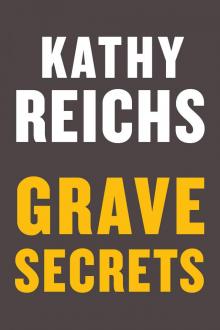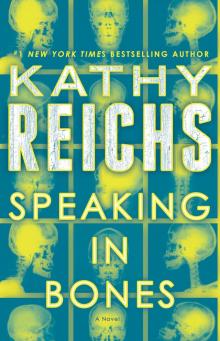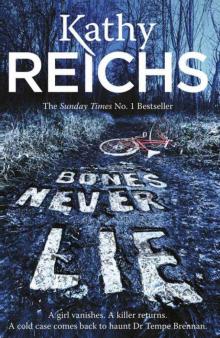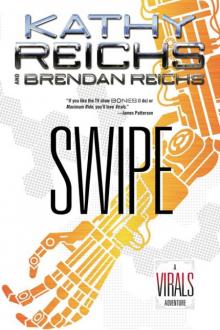- Home
- Kathy Reichs
Cross Bones Page 6
Cross Bones Read online
Page 6
Jake’s mug clunked the tabletop.
“Let me fast-forward a bit. In his popular book, Yadin touched briefly on the human remains recovered in Cave 2001. Shlomo Lorinez, an ultra-Orthodox member of the Knesset, read the thing and went ballistic. He’d missed the one press report back in sixty-five in which the skeletons were mentioned. Lorinez mounted a protest in the Knesset, charging that cynical archaeologists and medical researchers were violating Jewish law. He demanded to know where the remains were, and insisted on proper burial for the defenders of Masada.
“Major public controversy. The religious affairs minister and the chief rabbis proposed placement of all Masada bones in a Jewish cemetery on the Mount of Olives. Yadin objected, and suggested interment of the three palace skeletons at Masada, but reburial of the Cave 2001 folks in the cave in which they’d been found. Yadin was trumped, and in July of sixty-nine, all remains went back into the ground near the tip of the Roman ramp.”
I was finding this very confusing. Why would Yadin have opposed reburial of the cave bones on the Mount of Olives? Why suggest reburial of the palace skeletons on Masada, but return of the cave bones to the cave? Was it a question of keeping the cave folks off holy ground? Or was he uncomfortable with the idea of the cave folks and the palace folks sharing the same grave?
Charlie broke my chain of thought with a line from “Hey, Big Spender.”
“Did anything else turn up with the cave bones?” I asked.
“A lot of domestic utensils. Cooking pots, lamps, basketry.”
“Suggesting the caves had been lived in.”
Jake nodded.
“By whom?”
“It was wartime. Jerusalem was toast. All sorts of refugees might have fled to high ground. Some might have lived apart from the zealot community.”
Ah-hah. “So those in the cave could have been non-Jews?”
Solemn nod.
“Not what Israel wanted to publicize.”
“Not at all. Masada had become its sacred emblem. Jews making their last stand, choosing suicide over surrender. The site was a metaphor for the new state. Until recently, the Israeli military held special ceremonies inducting troops into their elite units on top of Masada.”
“Ouch.”
“According to Tsafrir, the cave bones were in disarray, with clothing fragments intermingled among them, as though the bodies had been dumped,” Jake said. “That’s not a typical pattern for Jewish burial.”
Birdie chose that moment to hop onto my lap.
I made introductions. Jake scratched the cat’s ear, then picked up his thread.
“To date, the Israel Exploration Society has published five volumes on the Masada excavation. Volume three notes that the caves were surveyed and excavated, but, aside from that, and a map with an outline drawing of Cave 2001, there’s no mention anywhere of anything found at that locus, human or material.”
Jake leaned back and picked up his mug. Lowered it.
“Wait. Change that. There is an addendum at the back of volume four. A carbon-fourteen report on textiles found in the cave. That testing was done years later. But that’s it.”
Displacing Birdie to the floor, I slid Kessler’s photo from below Jake’s Masada diagram.
“So where does this guy fit in?”
“That’s where things get really weird. Cave 2001 contained the remains of one fully intact skeleton completely separate from the intermingled bones. The individual was supine, with hands crossed, head turned to the side.” Jake impaled me with a look. “Not a single report mentions that articulated skeleton.”
“I assume you learned about the skeleton from this same volunteer who worked the cave back in the sixties.”
Jake nodded.
“This is the part where you tell me that the articulated skeleton wasn’t reburied with the others,” I guessed.
“This is the part.” Jake drained his mug. “Press coverage of the reinterment consistently refers to twenty-seven individuals, three from the northern palace, and twenty-four from the cave.”
“Not twenty-five or twenty-six. Maybe they left out the fetus.”
“I’m convinced they left out the fetus and the articulated skeleton.”
“Let me get this straight. You’re saying a volunteer excavator, an eyewitness, told you personally that he and Tsafrir recovered a fully articulated skeleton from Cave 2001. But no such skeleton was ever mentioned in press coverage, or in Yadin’s official report or popular book.”
Jake nodded.
“And you think that skeleton was not reburied with the rest of the cave and palace bones?”
Jake nodded again.
I tapped the Kessler photo. “Did this volunteer remember if photos were taken?”
“He snapped them himself.”
“Who had possession of the remains during their five years aboveground?” I asked.
“Haas.”
“Did he publish?”
“Nothing. And Haas typically wrote exhaustive reports, including drawings, tables, measurements, even facial reconstructions. His analysis of the burials at Giv’at ha-Mivtar is incredibly detailed.”
“Is he still alive?”
“Haas took a bad fall in seventy-five. Put him in a coma. He died in eighty-seven without regaining consciousness. Or writing a report.”
“So Haas won’t be clearing up the body count or the mystery of the intact skeleton.”
“Not without a séance.”
“Hey, big spender . . .” Charlie was sticking with a winner.
Jake changed tack. “Let me ask you this. You’re Yadin. You’ve got these strange cave bones. What’s the first thing you do?”
“Today?”
“In the sixties.”
“I was still losing baby teeth.”
“Work with me.”
“Carbon-fourteen testing. Establish antiquity.”
“I’ve told that back then carbon-fourteen dating wasn’t done in Israel. So tally this into the picture. In his rants to the Knesset, Lorinez insisted that some Masada skeletons had been sent abroad.”
“Lorinez was the ultra-Orthodox MK pushing for reburial?”
“Yes. And what Lorinez was saying makes sense. Why wouldn’t Yadin request radiocarbon dating on the cave burials?”
“So you think Lorinez was right,” I said.
“I do. But according to Yadin, no Masada bones left the country.”
“Why not?”
“In one Post interview I read Yadin said it wasn’t his job to initiate such tests. In the same article an anthropologist laid it off to cost.”
“Radiocarbon dating isn’t that expensive.” Even as long ago as the early eighties, testing only ran about $150 per sample. “Surprising Yadin didn’t order it, given the importance of the site.”
“Not as surprising as Haas’s failure to write up the cave bones,” Jake said.
I let things percolate a moment in my head. Then, “You suspect the cave folks may not have been part of the main zealot group?”
“I do.”
I picked up Kessler’s photo.
“And that this is the unreported articulated skeleton.”
“I do.”
“You think this skeleton may have been shipped out of Israel, and not reinterred with the others.”
“I do.”
“Why not?”
“That is the million-dollar question.”
I picked up the print.
“Where’s this fellow now?”
“That, Dr. Brennan, earns a million more.”
7
EACH YEAR, ONE HAPLESS BURG BECOMES Jamboree central for the American Academy of Forensic Sciences. For a week, engineers, psychiatrists, dentists, lawyers, pathologists, anthropologists, and myriad lab geeks converge like moths on a rolled-up rug. New Orleans drew the short straw this year.
Monday through Wednesday are given over to board, committee, and business meetings. On Thursday and Friday, scientific sessions offer insider tips
on cutting-edge theory and technique. As a grad student, then as a tenderfoot consultant, I attended these presentations with the ardent zeal of a religious fanatic. Now, I prefer informal networking with old friends.
Using either approach, the conference is exhausting.
Partly my fault. I volunteer for too much. Translate that to I do not struggle sufficiently against impressment.
I spent Sunday working with a colleague with whom I was coauthoring an article for publication in the Journal of Forensic Sciences. The next three days passed in a blur of Robert’s Rules, rémoulade, and rounds of drinks. Hurricanes for my booze-rational colleagues. Perrier for me.
Conversations centered on two topics: previous escapades and odd cases. Topping this year’s register of the bizarre and the baffling were skeletonized gallstones the size of Cocoa Puffs, a jailhouse suicide with a telephone cord, and a sleepwalking cop with his own bullet in his brain.
I floated a description of the Ferris case. Opinions differed concerning the peculiar beveling. Most agreed with the scenario I’d been considering.
My schedule did not permit sitting through the scientific papers. By the time I cabbed it to the New Orleans airport Wednesday, I was beat.
Mechanical problem. Forty-minute delay. Welcome to air travel in America. Check in a minute late and your flight has departed. Check in an hour early and your flight has been delayed. Mechanical problems, crew problems, weather problems, problem problems. I knew them all.
An hour later I’d finished entering committee minutes into my laptop, and my five-forty flight was posted for eight.
So much for the Chicago connection.
Frustrated, I dragged myself to customer services, stood in line, and obtained new routing. The good news: I would get to Montreal tonight. The bad news: I would land shortly before midnight. The additional bad news: I would visit Detroit on the way.
Frothing accomplishes little in these situations, other than raising one’s blood pressure.
At the airport bookstore, only a few million copies of the year’s blockbuster bestseller barred my way. I plucked one from the pyramid. The flap blurbed a mystery that would shatter an “explosive ancient truth.”
Like Masada?
Why not? The rest of the universe was reading the thing.
By wheels-down, I’d gotten through forty chapters. Okay. They were short. But the story was intriguing.
I wondered if Jake and his colleagues were reading the book, and if so, how they were rating the premise.
* * *
Thursday’s alarm was as welcome as a case of pinkeye. And almost as painful.
Arriving on the twelfth floor of L’édifice Wilfrid Derome, the building that serves as mother ship for the provincial police and forensics labs, I hurried straight to the staff meeting.
Only two autopsies. One went to Pelletier, the other to Emily Santangelo.
LaManche informed me that, following the request I’d made in my note, he’d asked Lisa to revisit Avram Ferris’s head. She’d retrieved additional fragments and sent them upstairs from the morgue. He asked when I anticipated finishing my analysis. I estimated early afternoon.
Sure enough, seven shards lay beside the sink in my lab. Their LSJML number matched that assigned to Ferris’s corpse.
After grabbing a lab coat, I played my phone messages, and returned two calls. Then I settled at my sand bowls and began jockeying the newcomer fragments into my reconstructed segments.
Two called the parietal home. One locked into the right occipital. One was a loner.
Three filled in the edge of the oval defect.
It was sufficient. I had my answer.
I was washing up when my cell warbled. It was Jake Drum with a miserable connection.
“Sounds like you’re calling from Pluto.”
“No service . . .”—the line crackled and spit—“. . . ince Pluto’s been demoted from planet to . . .”
Demoted to what? Moon?
“You’re in Israel?”
“Paris . . . nd changed plans . . . the Musée de l’Homme.”
I listened to a long stretch of transatlantic popping and sputtering.
“Are you phoning on a cellular?”
“. . . ocated an accession number . . . missing since the . . . eventies.”
“Jake. Call me back on a land line. I can hardly hear you.”
Apparently Jake couldn’t hear me either.
“. . . eep looking . . . all you back on a land line.”
My phone beeped and went dead.
I clicked off.
Jake had gone to Paris. Why?
To visit the Musée de l’Homme. Why?
Mental head slap.
I took Kessler’s photo to the scope, flipped it, and viewed the notation under magnification.
October, 1963. M de l’H.
What I’d taken to be the digit 1 was a lowercase L. And Ryan had been right. The first H was actually a smeared M. M de l’H. Musée de l’Homme. Jake must have recognized the abbreviation, flown to Paris, visited the museum, and dug up an accession number for the Masada skeleton.
LaManche wears soft-soled shoes and keeps his pockets empty of coins and keys. No scuffs. No jingles. For his bulk, the man moves extraordinarily quietly.
My mind was shaping the next “why?” when my nose sent it the scent of Flying Dutchman.
I swiveled. LaManche had entered through the histo lab and was standing behind me.
“Ready?”
“Ready.”
LaManche and I took seats, and I placed my reconstructions between us.
“I’ll skip the basics.”
LaManche smiled forgivingly. I bit my tongue.
Picking up the segment that had comprised the right posterior of Ferris’s skull, I pointed my pen.
“Oval defect with radiating fractures.”
I indicated the spiderweb of intersecting cracks on that segment and on two others.
“Concentric-heaving fractures.”
“So the entrance is behind and below the right ear?” LaManche’s eyes remained on the segments.
“Yes. But it’s complicated.”
“The beveling.” LaManche zeroed in on the problem.
“Yes.”
Returning to the first segment, I pointed to the external beveling adjacent to the oval defect.
“If the gun barrel is in tight contact with the skull, ectocranial beveling can be created by the blow-back of gases,” LaManche said.
“I don’t think that’s the case here. Notice the shape of the defect.”
LaManche leaned closer.
“A bullet entering perpendicular to a skull’s surface usually produces a circular defect,” I said. “A bullet entering tangentially produces an irregular perforation, often more oval in shape.”
“Mais, oui. A keyhole defect.”
“Exactly. A portion of the bullet actually sheared off and was lost outside the skull. Thus the external beveling at the entrance.”
LaManche looked up. “So the bullet entered behind the right ear and exited the left cheek.”
“Yes.”
LaManche considered that.
“Such a trajectory is uncommon but possible in suicide. Monsieur Ferris was right-handed.”
“There’s more. Take a closer look.”
I handed LaManche a magnifying lens. He raised and lowered it over the oval defect.
“The rounded end looks scalloped.” LaManche studied the oval for another thirty seconds. “As though the circle is superimposed on the oval.”
“Or the reverse. The border of the circular defect is clean on the skull’s external surface. But check inside.”
He rotated the segment.
“Endocranial beveling.” LaManche grasped it immediately. “It’s a double entrance.”
I nodded. “The first bullet hit Ferris’s skull straight on. Textbook. Outside border clean, inside border beveled. The second struck the same spot, but at an angle.”
&
nbsp; “Producing a keyhole defect.”
I nodded. “Ferris’s head moved or the shooter’s hand twitched.”
Fatigue? Sadness? Resignation? LaManche sagged as I voiced my ugly conclusion.
“Avram Ferris was shot twice in the back of the head. Execution style.”
* * *
That night Ryan cooked at my place. Arctic char, asparagus, and what we from Dixie call smashed potatoes. The spuds he baked, peeled, then worked with a fork, adding green onions and olive oil as he mashed.
I watched in awe. I’ve been called insightful. Brilliant even. When it comes to cooking, I have the vision of a guppy. Given an eon to ponder, my brain would never conceive a road map to mashed potatoes that did not pass through boiling.
Birdie was immensely appreciative of Ryan’s fruits de mer, and spent the evening trawling for handouts. Later, he settled on the hearth. His purring said feline life didn’t get much better.
Over dinner, I shared my conclusion regarding manner of death in the Ferris case. Ryan already knew. The investigation was now officially homicide.
“The weapon’s a Jericho nine-millimeter,” he said.
“Where was it?”
“Way back in a corner of the closet, under a cart.”
“Did the gun belong to Ferris?”
“If so, no one knew about it.”
I reached for more salad.
“SIJ recovered one nine-millimeter bullet from the closet,” Ryan went on.
“Only one?” That didn’t fit with my double-entry scenario.
“In a ceiling panel.”
Nor did that.
“What was a bullet doing overhead?” I asked.
“Maybe Ferris went for the shooter, they struggled, the gun discharged.”
“Maybe the shooter placed the gun in Ferris’s hand and pulled the trigger.”
“Simulated suicide?” Ryan.
“Every TV viewer knows you gotta have gunshot residue.”
“LaManche didn’t find any.”
“Doesn’t mean it wasn’t there.”
I munched and thought.
LaManche had recovered one bullet fragment from the victim’s head. SIJ had dug one bullet from the ceiling. Where was the rest of the ballistic evidence?
“You said Ferris may have been sitting on a stool when he took the shots?” I asked.
Ryan nodded.

 Two Nights
Two Nights The Bone Collection: Four Novellas
The Bone Collection: Four Novellas Fatal Voyage
Fatal Voyage 206 Bones
206 Bones Bones to Ashes
Bones to Ashes Terminal
Terminal Monday Mourning
Monday Mourning Flash and Bones
Flash and Bones Cross Bones
Cross Bones Devil Bones
Devil Bones Break No Bones
Break No Bones Swamp Bones
Swamp Bones Déjà Dead
Déjà Dead Shock
Shock Spider Bones
Spider Bones Death Du Jour
Death Du Jour Grave Secrets
Grave Secrets Trace Evidence: A Virals Short Story Collection
Trace Evidence: A Virals Short Story Collection Bones on Ice
Bones on Ice The Bone Code
The Bone Code Bones in Her Pocket
Bones in Her Pocket Seizure:
Seizure: Speaking in Bones
Speaking in Bones Deadly Decisions
Deadly Decisions Spike
Spike Bones Never Lie
Bones Never Lie Bones of the Lost
Bones of the Lost Virals 03.5 - Swipe
Virals 03.5 - Swipe Exposure
Exposure A Conspiracy of Bones
A Conspiracy of Bones Shift (tory brennan)
Shift (tory brennan) Bones of the Lost: A Temperance Brennan Novel tb-16
Bones of the Lost: A Temperance Brennan Novel tb-16 Virals tb-1
Virals tb-1 Bones Are Forever tb-15
Bones Are Forever tb-15 Code tb-3
Code tb-3 Seizure tb-2
Seizure tb-2 Deadly Descisions
Deadly Descisions Spider Bones: A Novel
Spider Bones: A Novel